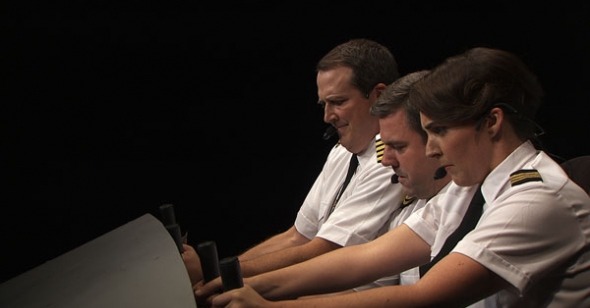Grounded
by Jeff Reichert
Charlie Victor Romeo
Dir. Robert Berger, Patrick Daniels, Karlyn Michelson, U.S., No distributor
Charlie Victor Romeo, a sort-of documentary and one of the more curious objects to hit theaters in some time, is comprised of six stark, theatrical reenactments of actual black-box flight recordings. Fair warning for those viewers harboring a fear of air travel: each of the reenactments takes place in the minutes before the plane in question crashed unexpectedly, often killing many on board. There is no narrative arc to the 3D-shot Charlie Victor Romeo; there are just different planes, different reasons for the crashes, all left opaque to the viewer until the arrival of a series of clinical slides announcing casualties and causes after abrupt cuts to black signifying the plane has gone down. A handful of performers rotate in and out of each scene (as in the 1999 play on which this film is based), so a pilot in one scene becomes the copilot of the next, and so on. As the film progresses, we merely watch pilots at work, and wait to see what happens in the cockpit when their planes drop from the sky.
Shooting on a shadowy set ringed with flight instruments and featuring a strategically placed door suggesting the main cabin area filled with passengers we’ll never see (the overall design is tilted more towards a sense of “cockpit” than verisimilitude), filmmakers Berger, Daniels, and Michelson exhibit an impressive command over their limited mise-en-scène. There’s no camera movement in the film save for the occasional ominous push in and out over the dashboard, but their sharp, rhythmic cutting, which highlights discrete sets of images—twinned hands straining against the plane’s yokes; beatific frontal close-ups of the pilots, lit as if from the heavens above; the mouth of an air traffic controller frantically spewing unintelligible instructions—never pushes into abstraction, even though, as tension mounts, the cuts come faster and faster. The filmmakers’ overall aesthetic strategy most immediately recalls how Bresson recreated the trial of Joan of Arc from transcripts and just a handful of disconnected master shots.
Though each sequence begins and ends in nearly identical fashion (with one excruciating exception, in which the plane is already crashing as the scene begins), Charlie Victor Romeo manages to milk surprising amount of dramatic variety from its limited elements. Watching the pilots trade jokes with flight attendants, tell random tales, or just complain about the weather with the knowledge that these are the conversations that actually occurred lends each hiccup, stutter, and stumble in the performances documentary value. The filmmakers fill in nicely between the lines as well; in the lapses in dialogue we can locate a knowing glance between pilot and copilot, or another pilot turning to watch a flight attendant’s ass as she walks back to the main cabin, nonverbal choices clearly not captured in the “record” but also tonally and contextually appropriate. The performers have all the polish of your local theater troupe, but there’s a calculated stiltedness to their overall delivery that continually highlights the absurd improbability of the project as a whole.
Throughout Charlie Victor Romeo, the tension created from the simple knowledge that the infernal beeping of the warning klaxons will, with absolute certainty, begin to sound is near unbearable. Every plane must crash, but when? And how? Given that, the question for many considering seeing Charlie Victor Romeo might then be: Why watch a ghoulish contraption like this? Well, for some of the same reasons anyone buys a ticket for the horror movie: the pleasure of suspense, of not knowing when or how disaster might strike, and then, once pushed to the brink, the hopeful possibility of some kind of release. Release here, however, usually means that the truly dire has occurred, and the filmmakers provide no solace, merely a cut to black followed by the antiseptic presentation of statistics that, given what’s just been witnessed, hit like a punch in the gut. That the filmmakers are able to push our buttons so successfully and repeatedly with so few trappings suggests that they’ve managed to excavate and transmit some core fundamentals of suspense mechanisms. The effect is not unlike watching one of the Dardennes brothers’ thrillers, all drenched in free-floating anxiety, but the execution here is worlds away.
Unlike in Paul Greengrass’s atrocity exhibition United 93, there’s no attempt at mythmaking in Charlie Victor Romeo, no straining to elevate the principals to the level of heroes, which only exploits them further. There’s merely pilots and copilots and air traffic controllers going about their work under impossibly tense circumstances, trying to puzzle their way to a solution that will bring the massive planes safely to the ground, and usually failing. Without a master narrative to adhere to, the film asks us to consider the differences between the scenarios, and how words sound in combination, especially words that make little sense to the viewer, yet have immense meaning for the speaker—as the planes come closer and closer to crashing, the amount of aviation terminology spouted often reaches a dizzying point. Charlie Victor Romeo explores the deliciousness of movie tension, yes, but is perhaps most fascinating as a diagram of the seductive poetry of jargon and the lyricism of everyday pitter-patter. The filmmakers here have amply proven, with their highly odd contraption, something that realism-minded art filmmakers the world over have been arguing with their cinema for decades: that there may be no more fascinating (and often terrifying) subject for film than the rhythms of everyday life.
